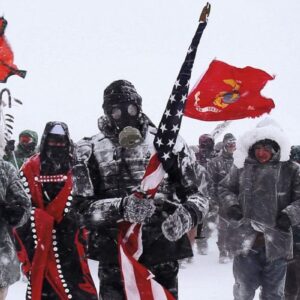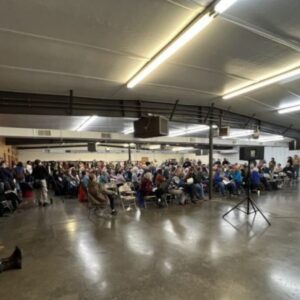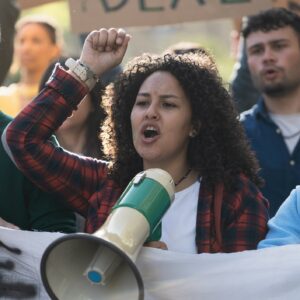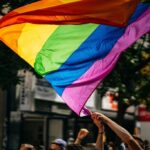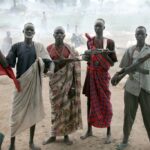
Wildfires and floods have dominated world news this year, impacting hundreds of thousands of people as these disasters continue to increase in intensity. Many people use these widespread events to point out that climate change does not discriminate. But the truth is, it does.
While it is correct that everyone will feel the effects of climate change, the extent to which it impacts people differs—people’s access to information and knowledge, for example, is one of the most important differentiating factors. During the wildfires in Los Angeles earlier this year, a UCLA study showed that affected communities with limited English proficiency suffered specific challenges as a result of not being able to understand alerts and information shared.
As the climate crisis worsens, we’re encouraged to talk about it, raise awareness, and take action, but what happens when people are left out at the very first step?
The Barriers of Language
Only about two billion of the world’s population of roughly eight billion people speak English. However, almost 90 percent of scientific publications are in English and a majority of the conversations around climate—particularly anything related to policy, adaptation, or disaster response—are in English as well. This means that a large portion of immigrant communities in English-speaking countries like the United States and United Kingdom, and most of the rural populations in the Global South are left out of the climate conversation.
“What you’re looking at is a situation where English is an elite language so [it] is, paradoxically, a language that unites people but also divides them. A bit like wealth….Those who have wealth accumulate more wealth, so those who [know] English have access to all kinds of information, and those who don’t are cut off,” said Mario Saraceni, associate professor in English Language and Linguistics at the University of Portsmouth, in the United Kingdom.
This doesn’t mean non–English speakers are unaware of the climate crisis—they are often the ones most directly impacted by severe weather. They also have their own unique, diverse knowledge of the land they inhabit, which can lead to Indigenous and local climate solutions that can not only stave off the worsening conditions but also be restorative. And yet, because this knowledge is often not communicated in English, their knowledge remains isolated from the rest of the world.
A large portion of immigrant communities in English-speaking countries…are left out of the climate conversation.
We push for a bigger, global solution to the climate crisis but until we make climate communication truly accessible, we will remain stuck in the same elite circles. With a growing understanding of language barriers, linguistic and climate experts are demanding better from climate scientists and communicators, aiming to ensure all voices can be part of the conversation—but it won’t happen overnight.
The Inaccessibility of Climate Information and Communication
Conversations around who gets access to disaster warnings and preparedness are gaining traction now as more immigrant communities find themselves increasingly vulnerable. For Cesar Espinosa, cofounder of FIEL (Familias Inmigrantes y Estudiantes en la Lucha/Immigrant Families and Students in the Fight)—the largest immigrant-led civil rights organization in Texas—navigating language is perhaps one of the most crucial parts of advocacy.
“Houston is a very diverse city, so we speak English and Spanish but also Vietnamese and Arabic and Farsi, so here we don’t see that disconnect in language as much as other parts of the country,” he told NPQ. “I know in other parts of the country folks are not getting information in their language so they are getting lost.”
Monica Jahan Bose, a Bangladeshi American artist and climate activist, says she finds the language used in climate circles peculiar. “Even in Bangladesh I’ve been invited to, and attended, several climate forums and I attended one about bringing climate conversations to remote farmers and it was all in English,” Bose shared in an interview, pointing out that by holding these forums in English, organizers fail to reach the communities they claim they want to help.
She added that when she reached out to many of the people involved in the forum to get resources for the women of her ancestral village that she was working with, she rarely got a response.
This exclusion is often born from the idea that some people are more worthy to talk about climate because of their background and the language they speak. The phenomenon is widespread. A report from April 2025 showed that Indigenous peoples make up just 6 percent of the global population, they safeguard 80 percent of the planet’s remaining biodiversity, and yet they receive less than 1 percent of international climate funding. There have been demands from as early as 2021 to stop excluding global youth, particularly those most affected in rural areas, from climate conversations—and there have been calls since then to center young leaders in responding to the climate crisis.
For many Indigenous communities…key ancestral concepts about the land may not be translated into English, and therefore are not recognized by the mainstream.
Bose points out that she has also worked with Bangladeshi American communities in the United States and has found that many nonprofits in this sector are dominated by people speaking English who are unable to communicate with immigrant communities.
“These big conferences aren’t the only places we should have climate conversations. I do think a lot of people still don’t have basic knowledge, and there’s a lot of information that can be shared,” Bose said.
Max Boykoff, a professor of Environmental Studies at the University of Boulder, CO, shares similar observations, particularly from his time experiencing a Category 5 hurricane in Honduras in 1998.
“Those who are at the forefront of climate impact are often those with the least heard in mainstream media accounts. That’s something I saw in Honduras in the hurricane where the media coverage was mainly around the capital city which was less affected than other rural areas,” he shared with NPQ.
Climate Cardinals, one of the leading nonprofit organizations in accessible climate communication, was founded to address the barriers that communities across the world experience.
“One thing is that academic language is on purpose a barrier to not include people into spaces, and Climate Cardinals is actively working to break that down,” said Carl Philip Dybwad, chief operating officer at Climate Cardinals, in an interview with NPQ.
These barriers in knowledge also extend the other way. For example, for many Indigenous communities, key ancestral concepts about the land may not be translated into English, and therefore are not recognized by the mainstream—leading to gaps in understanding in English-language academia and media.
“The reason why information doesn’t flow from the periphery is because of a more general situation where the center speaks to the periphery [but] doesn’t listen to the periphery,” Saraceni pointed out.
Espinosa, who has experience working with some of the most vulnerable immigrant communities in Texas at a time when climate migration—to and within the United States—is at an all-time high, also pointed out that “oftentimes we rely on Western ideas to be able to put things out or explain the way things are working but we don’t really take into consideration all the Indigenous knowledge that exists, especially in mainstream US society where it’s considered ‘primitive.’”
“Everyone should understand that climate change is a slow falling airplane—if you look out your window it doesn’t look bad but it’s constantly going down and everyone’s running away from responsibility.”
Making Climate Communication for Everyone
As Espinosa shares, the climate crisis is affecting people regardless of their race, class, or immigration status, so it’s important that everyone has the same tools to fight it—but not being able to understand information puts many communities at a disadvantage.
Bálint Forgács, an experimental psychologist and cognitive neuroscientist who studies figurative language, started working on climate-related issues during the COVID-19 pandemic. He points out that the complex language used around climate means that very few people actually understand the intensity and consequences of the climate crisis.
“I think what could dramatically improve is using an invention of vivid analogies and metaphorical visual images that are close to [people’s] local and everyday way of living, which doesn’t even necessarily involve their cultural heritage,” Forgács told NPQ. “But everyone should understand that climate change is a slow falling airplane—if you look out your window it doesn’t look bad but it’s constantly going down and everyone’s running away from responsibility.”
Forgács added that “science is abstract when it reaches the public as a discussion; what comes out from those conferences should be a message that’s not detached from everyday experience.”
Dybwad points out that this is a big part of Climate Cardinal’s overarching goal, which they are hoping to achieve through empowering their local chapters in countries across the globe.
“Because chapters are already carrying out localized climate action, they are working on adaptation and resiliency,” he said. “We want to give more opportunity to people who are grassroots and are on the ground and we’re trying to ask ourselves, ‘Are we the best person to talk about this, or is there someone local who can better speak about this?’”
He acknowledges that being from Norway and now being based in New York puts him in a position where he cannot speak for the lived experiences of most immigrant communities across the United States or across the world.
“I think it’s important for us to realize that language, and having access to different languages is key to moving any policy or idea forward,” Espinosa shared, “so I think that would be a base point—language accessibility—both spoken and written because at the end of the day we have to realize as communities we have more in common than we don’t.”
